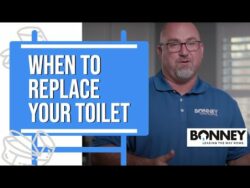The article, titled “How to Fix a Running Toilet that Won’t Stop Running,” provides a comprehensive guide on fixing a running toilet. You will find a video by Kendall Todd TheSilverGuy, who demonstrates the steps to fix the problem effectively. The content emphasizes that this DIY repair is a quick and relatively easy fix that can save you money on plumber costs.
The article highlights the common causes of a running toilet, such as a faulty flapper or flush valve, and provides instructions on how to replace these components. It also stresses the importance of fixing a running toilet promptly to prevent water waste and high water bills. This article is a valuable resource for anyone looking to resolve a running toilet issue on their own.

Having a running toilet can be frustrating and costly. Not only does it waste water, but it can also lead to higher water bills. Fortunately, fixing a running toilet is often a simple DIY task that can be done without the need for professional help. In this comprehensive guide, we will explore the common causes of a running toilet and provide step-by-step instructions on how to fix it. We will also discuss the tools and materials needed, troubleshooting tips, and the importance of addressing a running toilet promptly.
Common Causes of a Running Toilet
Before we delve into the steps to fix a running toilet, it’s essential to understand the common causes that can lead to this issue. By identifying the cause, you can effectively troubleshoot and resolve the problem. Here are some common causes of a running toilet:
Old or faulty flapper
The flapper is a rubber or plastic mechanism that controls the flow of water from the tank to the bowl. Over time, the flapper can deteriorate, become warped, or accumulate mineral deposits, resulting in a poor seal. This can cause water to continuously leak from the tank into the bowl, leading to a running toilet.
Faulty fill valve
The fill valve, also known as the ballcock or inlet valve, is responsible for regulating the water level in the tank. If the fill valve is faulty, it may not shut off properly after the tank is filled, causing water to continually flow into the tank and resulting in a running toilet.
Stuck or faulty flush valve
The flush valve is what allows water to exit the tank and enter the bowl during a flush. If the flush valve is stuck in the open position or not properly sealed, water will continuously flow from the tank to the bowl, causing a running toilet.
Malfunctioning toilet handle
The toilet handle is connected to the flushing mechanism inside the tank. If the handle is loose, misaligned, or not functioning correctly, it can cause the toilet to continuously run or not flush properly.
Incorrect chain length
The chain inside the tank connects the toilet handle to the flapper. If the chain is too long or too short, it can interfere with the proper operation of the flapper, leading to water leakage and a running toilet.
Now that we have identified the common causes of a running toilet, let’s move on to the tools and materials you will need to fix it.
Tools and Materials Needed
To fix a running toilet, you will need the following tools and materials:
Adjustable wrench
An adjustable wrench will be useful for loosening and tightening various nuts and bolts inside the toilet tank.
Screwdriver
A screwdriver, both flathead and Phillips head, will be necessary for removing and installing screws and other fasteners.
Replacement flapper
If the flapper is old, worn out, or not sealing properly, you may need to replace it with a new one. Make sure to choose a flapper that is compatible with your toilet model.
Replacement fill valve
If the fill valve is faulty or not shutting off properly, you may need to replace it with a new one. Again, ensure that you select a fill valve that is compatible with your toilet.
Replacement flush valve
If the flush valve is stuck or not sealing correctly, you may need to replace it. It’s important to choose a flush valve that matches the specifications of your toilet.
Replacement toilet handle
If the toilet handle is loose, misaligned, or not functioning correctly, you may need to replace it with a new one. Select a toilet handle that matches the design and style of your toilet.
Chain cutter or pliers
If the chain connecting the handle and flapper is too long, you may need to adjust its length. A chain cutter or pliers can be helpful in trimming the chain to the appropriate length.
Towels
Having a few towels on hand can help catch any water spills or leaks during the repair process, preventing damage to your bathroom floor.
Now that you have gathered the necessary tools and materials, let’s proceed to the step-by-step guide on how to fix a running toilet.
Step-by-Step Guide: How to Fix a Running Toilet
Before starting any repairs, it’s crucial to turn off the water supply to the toilet. You can usually find a shut-off valve near the base of the toilet or near the main water supply line. Once the water supply is turned off, flush the toilet and empty the tank. This will allow you to work on the internal components without water interference. Now let’s proceed with the step-by-step guide:
Turn off the water supply
Locate the shut-off valve near the base of the toilet or along the main water supply line. Turn the valve clockwise until it is fully closed to stop the flow of water to the toilet.
Flush the toilet and empty the tank
Press and hold down the toilet handle to flush the toilet and empty the tank completely. This will ensure that there is no water left in the tank while you work on the internal components.
Replace the flapper
Inspect the flapper for any signs of damage or wear. If necessary, remove the old flapper by unhooking it from the overflow tube and disconnecting the chain. Install the replacement flapper by connecting it to the overflow tube and attaching the chain to the flush lever. Ensure that the chain has enough slack to allow the flapper to close fully but not so much that it becomes tangled or caught.
Replace the fill valve
If the fill valve is faulty or not shutting off properly, you may need to replace it. Follow the manufacturer’s instructions on how to remove the old fill valve and install the new one. Make sure to tighten all connections securely and adjust the water level using the adjustment screw or float.
Replace the flush valve
If the flush valve is stuck or not properly sealed, it may need to be replaced. Consult the manufacturer’s instructions for your specific toilet model on how to remove the old flush valve and install the new one. Ensure all connections are tight and the flush valve is properly aligned.
Replace the toilet handle
If the toilet handle is loose or not functioning correctly, you may need to replace it. Begin by removing the mounting nut or screws that secure the handle to the tank. Install the new handle by inserting the handle arm into the mounting hole and securing it with the mounting nut or screws.
Adjust the chain length
Check the chain length connecting the handle and flapper. If it is too long, use a chain cutter or pliers to trim it to the appropriate length. If it is too short, replace the chain with a new one of the correct length. Ensure the chain has enough slack for the flapper to close fully but not so much that it becomes tangled or caught.
Turn on the water supply
Once you have completed the necessary repairs and adjustments, turn on the water supply to the toilet by opening the shut-off valve. Allow the tank to fill and check for any leaks or abnormal water flow. If everything is functioning correctly, move on to the next step.
Test the toilet
With the water supply turned on and the tank filled, flush the toilet to check for proper operation. Ensure that the toilet flushes smoothly, refills to the appropriate water level, and the flapper closes fully to prevent water from running continuously.
Congratulations! You have successfully fixed your running toilet. Now let’s explore some troubleshooting tips to help you address any persistent issues.
Troubleshooting Tips
While the steps outlined above should resolve most running toilet issues, there may be instances where further troubleshooting is required. Here are some troubleshooting tips to consider:
The toilet still running after the replacement
If your toilet continues to run even after replacing the flapper, fill valve, and flush valve, check for any additional leaks or problems with the tank components. Inspect the overflow tube, water supply line, and other connections for any signs of damage or leaks. Tighten any loose connections or consider consulting a professional plumber for further assistance.
Weak flush or incomplete flush
If your toilet flushes weakly or incompletely, the problem may be related to a clogged or partially blocked toilet trap or drain. Use a plunger or a toilet auger to clear any obstructions in the drain and restore proper flushing.
Leaking water
If you notice water pooling around the base of the toilet or any persistent leaks, check the wax ring seal between the toilet and the floor. A worn or damaged wax ring can cause water to seep out and require replacement.
Difficulty in finding replacement parts
If you’re having trouble finding the exact replacement parts for your toilet, consider reaching out to the toilet manufacturer or a plumbing supply store for assistance. They can help you identify suitable alternatives or provide guidance on obtaining the necessary parts.
Conclusion
A running toilet can be a nuisance, but with the right knowledge and tools, you can easily fix the problem yourself. By understanding the common causes of a running toilet and following the step-by-step guide, you can save money on water bills and prevent unnecessary water waste. Remember to promptly address any running toilet issues to avoid potential damage and higher costs in the long run. Happy repairing and enjoy a functional, leak-free toilet!





